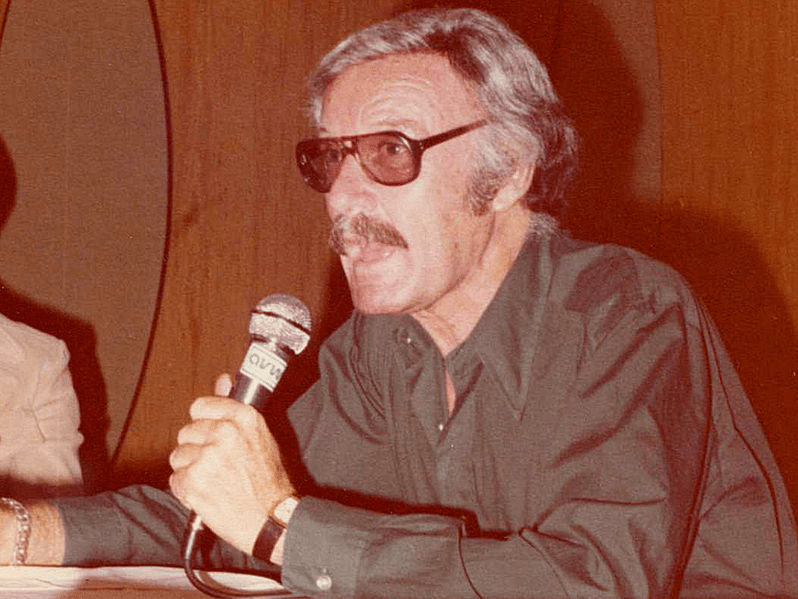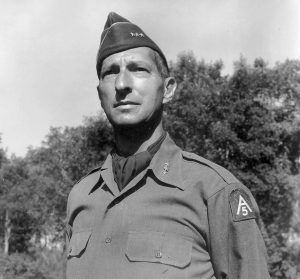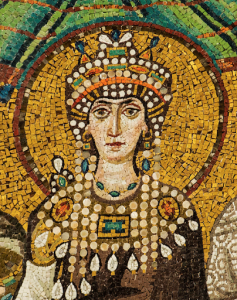Stanley Martin Lieber loved storytelling growing up, as most of his childhood was spent reading works by Sir Arthur Doyle, Mark Twain, and William Shakespeare, although he did not fully understand them. Stanley would use these books as an escape from his family’s troubles during the Great Depression. He loved storytelling and dreamed of one day writing his own great novel. Today he is better known as co-creator of many Marvel Comics characters, but he started from humble beginnings working for Timely Comics (now famously known as Marvel Comics) in 1939 as an assistant to Captain America creators Joe Simon and Jack Kirby.1
With Stanley’s new full-time job, he saw himself laying the foundation for his dream career in writing, hoping one day to be like his favorite authors and write his own great novel. Although his new job as assistant to Simon and Kirby had him running errands and doing chores, Stanley did not complain, because he was grateful to have a job during the lean days of the Depression. One day, to his surprise, Simon and Kirby threw him an assignment to create a filler story for the third issue of Captain America. The two co-creators wanted to see if he, Stanley, had any writing talent. With the publishing of the third Captain America issue, Stanley was credited with the work he did on it, but he did not use his own name; instead, he used the alias Stan Lee; and that is how most people know him today. He used this pseudonym because he actually felt embarrassed about writing comic books, which he thought were childish; moreover, he still wanted to be remembered for the great American novel he still dreamed one day to write.2

Throughout the 1940s, comic books grew in popularity, and with popularity came rising demand. Timely Comics needed to keep up with this demand if it wanted to stay in business. Timely was already a small operation at the time and with this growing demand, it needed as many writers as possible. Although Stan was young and inexperienced, Timely offered Stan Lee a chance to create his own characters. With Stan’s new position in creating characters and meeting deadlines for stories, he unfortunately had no choice but to put his life-long dream to the side. Although still being able to be a great storyteller, comic books were not how Stan saw his future. He still saw himself as a serious novelist that would one day write that “great American novel.”
In the mid-1950s, the comic book industry was under attack by psychiatrist Fredric Wertham, who claimed that violence, sex, and horror in comic books were responsible for juvenile delinquency. Juvenile delinquency was already a prominent concern in the 1950s due to other media influences, like in film, with movies like Rebel without a Cause starring James Dean, and in music, with songs of the new genre of rock’n’roll. Rock was becoming ever more popular among teenagers, with songs like “Youth Gone Wild” by Skid Row, among dozens of other songs at the time that played a hand in encouraging the youth to be daring and risky. Crimes committed by teenagers seemed to be on the rise. Wertham used this to his advantage, saying that juvenile delinquency was a problem in society due mainly to the influence of comic books. These claims by Wertham brought the establishment of the Comics Code Authority, which policed comic books for objectionable material. As a result, sales of comics dropped. Comic books were so popular because, although fictional, they would touch on real life issues. The result of Wertham’s efforts was that the comic book industry was brought to its knees with the establishment of the Comics Code Authority. With the comic book industry in a dire situation, Martin Goodman (C.E.O. of Timely) had Stan lay off a majority of the staff at Timely Comics so that Goodman’s company could financially stay alive. Over time, Stan grew tired of writing comic books, and even considered quitting his job. Between the backlash comics were receiving, and having to lay off the majority of his co-workers/close friends, Stan felt hated and guilty. Moreover, Goodman continuously pressured Stan to write stories for characters he had little to no interest in, which also made him feel trapped and unhappy.3

Stan’s career in comics had become an anchor around his neck, and his dream of ever becoming a novelist felt like a distant mirage that he would never be able to reach. In the late 1950s, Stan brought his conflict to his wife Joan. Joan suggested that he think of a comic book story that he wanted to tell with characters he wanted to create and publish. She told Stan, “the worst Goodman can do is fire you, and you’re thinking about quitting anyways.”4 Joan sparked one last bit of hope in Stan that would motivate him to create something never seen before in comics. Sometime before bringing his dilemma to Joan, Goodman had come to Stan and ordered him to create a superhero team that could rival DC Comics’ Justice League of America in popularity. Stan saw this as his last chance to make something of himself in the comic book world. With Goodman’s demand and Joan’s advice, Stan created one of the most iconic superhero teams ever: The First Family of Marvel: The Fantastic Four. Although he never ended up writing his great American novel, Stan found an outlet for his creativity with the successful launch of The Fantastic Four. Stan created a group of superheros that battled villainy as much as domestic issues at home, because they were heroes that were a family: brother and sister, Johnny and Sue Storm aka The Human Torch and The Invisible Woman. Sue was married to Reed Richards aka Mr. Fantastic, and Ben Grimm aka The Thing, Reed’s best friend, who was essentially a big brother figure to hot head Johnny Storm. Stan created the Fantastic Four to stand out, he created them to be a family with a twist, Reed was the Father of the family/leader of the group, and Sue was his wife. Johnny was created to appeal to the younger audience as he was the young kid brother. Ben was the twist in the family. Besides having powers, Ben was made to be a gentle giant and lovable monster that would be a close friend of the family. Ben and Johnny would often prank each other while on a mission or inside The Baxter Building (home base of The Fantastic Four). Ben was also created to be connected to Reed as a sense of guilt for Reed. Reed was responsible for the experiment that gave the team superpowers, and Ben was disfigured as a result. Reed would always carry the guilt of Ben’s disfigurement even though Ben had come to terms with his new look.5

The creation of The Fantastic Four was the turning point for Stan Lee and Timely Comics, (now officially Marvel Comics). Stan received mail from fans demanding more from The Fantastic Four and for Stan to create costumes for the characters, because in their first appearance, Stan created them without superhero costumes. The First Family of Marvel changed everything. They set the foundation to how superheroes would be created in The Marvel Universe. Audiences were able to empathize with their favorite characters like never before in the comic book world. The connection between characters and audiences skyrocketed Stan’s and Marvel’s future and prominence in the comic book world, and both Stan and Marvel became icons.
Unfortunately, Stan Lee passed away at the age of ninety-five on November 12, 2018, due to congestive heart failure. Many people mourned on that day because Stan Lee was loved by his fans; his material touched audiences all over the world. Stan Lee built his legacy from the ground up. He started as assistant to Joe Simon and Jack Kirby, became editor and chief, and then creator to some of the most memorable characters of The Marvel Universe that we know and love today. Stan Lee will be missed by many. He is gone but never forgotten, Excelsior!!! To The King of Comic Books.
- St. James Encyclopedia of Popular Culture, 2013, s.v. “Marvel Comics.” Bradford W. Wright, 473-475. ↵
- Bob Bachelor, Stan Lee: The Man Behind Marvel (Maryland: Roman & Littlefield publishers, September 5, 2017), 33-38. ↵
- Contemporary Authors, New Revision Series, 2004, s.v. “Lee, Stan 1922-“, 244-246. ↵
- Anthony Breznican, “Stan Lee: A Life of Marvel,” Entertainment Weekly, November 30, 2018, 24-26. ↵
- Anthony Breznican, “Stan Lee: A Life of Marvel,” Entertainment Weekly, November 30, 2018, 8-9. ↵



56 comments
Bryon Haynes
In a time when men were committing suicide as a result of what they had lost, Stan finding peace within the novels he read and desiring the opportunity to create something just as impactful to the point where he was patient for that opportunity and took the time to learn from successful comic creators spoke volumes about how hungry he was for this. Using escapism to further ground Stan Lee’s origin story is brilliant because it provides us with an authentic perspective on how he lived. It’s even more moving when you consider that it was the Fantastic Four, a team centered on family dynamics that his wife undoubtedly influenced given how involved and encouraging she was throughout his journey to success.
Iris Reyna
I love marvel and anything to do with the franchise. Anyone that’s a fan of marvel knows who Stan Lee is. Reading this article has shown me that I didn’t know much about the king of comic books. I knew he went through a lot to get to where he was and how he made Marvel what it is today. Now knowing how he struggled and the obstacles he had to face makes me appreciate and respect Stan Lee so much more. What stood out to me the most was what Joan told Stan, “the worst Goodman can do is fire you, and you’re thinking about quitting anyways.”. If Stan didn’t follow the advice given and didn’t taken the leap we wouldn’t have marvel the way it is today so thank you king of comic books. Great Job on the article.
Esteban Serrano
Hello Eliezar,
Great job on your research! I really enjoyed reading this informative article. Stan Lee was a legend writer and a legend creator. I will forever put him up there on the “hall of fame” of literature with Shakespeare, Fitzgerald, Orwell, and more. Lee had a way of creating his characters and making them more than just superheroes. I don’t know what it is. He was such an amazing writer and all around guy. Great job on your research, once again. Congrats on your publication!
Serenity Kamenski
Reading your article made me realize that I truly did not know a lot about man behind such a largely popular media franchise. It was kind of shocking to read about how Stan Lee had moments in his career where he didn’t enjoy what he was creating, and it was a even bigger surprise to learn about his dream of becoming a serious novelist rather than a comic writer. It makes me want to appreciate his work even more so through knowing the hardships he faced to produce such fascinating stories. He truly is the king of comic books. Great article by the way.
Aidan Farrell
Absolutely amazing. I loved reading this article very much. I am a religious fan of marvel comics, including the films, but I did not really not know much about the man behind it all. This article really helped me understand what Stan Lee had to go through in his life to get to the point of creating the biggest comic book franchise in history. Honestly, it was a beautiful read. it was cool to learn that Stan Lee has been into literature since the start of his life. Who know it would have such an impact.
James Clark
This article was interesting to read, As someone who enjoys comic books and superheroes, Stan Lee truly is an amazing person. He brought life to so many unique ideas and made each of them fun and interesting. It’s interesting to see how Marvel comics came to be the large corporation it is today. Also, how Stan Lee even into his last years was a big part of the franchise and was a kid at heart. He appeared in every Marvel movie as a cameo and loved the way his stories were adapted to the big screen.
Aticus Ovalle
Stan the Man is one of my true heroes who I idol to this very day. To see so many of his creations come to fruition and make so many people happy really does strike a chord within my heart that will always make me want to put my imagination to work. The stories of this article present me with new info that I had never known about and I was glad to learn new facts.
Davis Nickle
This article actually taught me a lot of new things about the legendary Stan Lee. For one I did not know that Stan Lee was just a pseudonym that he used because he was embarrassed. I was also really surprised to read that he started to hate his job and considered quitting. At the end of the day I’m glad he stuck with comics because his characters would make tons of people around the world happy.
Angela Calderon
Loved reading this article about a pivotal moment in the departed Stan Lee’s life. Reading this was almost like reading his “origin story” along with Marvel’s, which is the kind of story I’m sure he wrote a lot himself as a Marvel character creator. Based on the series of events laid out in this article, Marvel wouldn’t be where it is today as a franchise without his actions and creations. I love every single one of the movies they have come out with and every single cameo Stan Lee has made in the ones preceding his death. In the end, no one can deny that he really did make his dream a reality since he created a good many “great American novels” through Marvel Comics, and his legacy will be long-lasting because of it.
Ana Cravioto Herrero
I absolutely love Stan Lee and I am obsessed with Marvel. He is such an iconic person and his creativity is unparalleled. I love how he stars in his own movies by popping up as a random character or extra, and I still get so happy when I see him pop up in the movies. He dies doing what he loved and as you said, he will always be loved and admired by everyone who is aware of his work.